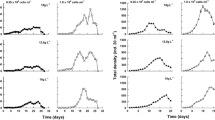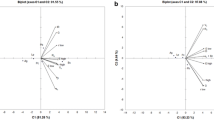Abstract
We compared the demographic variables and bacterivory of two strains of Diaphanosoma mongolianum from two water bodies in Spain, one without Microcystis (Maidevera in Zaragoza) and the other with dense Microcystis (La Albufera of Valencia). We hypothesized that the strain rarely exposed to Microcystis would be unable to grow on this cyanobacterial diet. We fed both strains Monoraphidium caribeum and Microcystis aeruginosa, together and separately, and compared their demographic variables. Monoraphidium caribeum was cultured in the laboratory on a defined medium, while the cyanobacteria were collected from La Albufera and sonicated before feeding the cladocerans (at 0.5 × 106 cells ml−1). We also tested the growth of D. mongolianum on bacterial diets by using seston (0–15 µm), bacterioplankton (0–3 µm) and mixed fractions (3–15 µm), from sieving Lake Albufera. We conducted population growth and life table demography experiments at 25 °C, using the two strains of D. mongolianum. Both strains had r (population growth rate) ranging from 0.05 to 0.3 d−1, on all diets. The r was higher (0.18 d−1) on the 0–15 µm seston compared to the mixed fraction (0.12 d−1) although D. mongolianum also grew well on bacterioplankton (0.16 d−1) alone. The response of the strains collected from two different water bodies was different to the test diets. We found that both strains of D. mongolianum could effectively utilize Microcystis for survival and growth, regardless of previous exposure to the cyanobacteria. The tested cladocerans could also grow well on small sized food particles (0–3 µm and 0–15 µm). Our results explain why D. mongolianum is common in eutrophic water bodies








Similar content being viewed by others
Data availability
Data will be made available by the corresponding author on reasonable request.
References
Agrawal M, Bagchi D, Bagchi S (2001) Acute inhibition of protease and suppression of growth in zooplankter, Moina macrocopa, by Microcystis blooms collected in Central India. Hydrobiologia 464:37–44. https://doi.org/10.1023/A:1013946514556
Ahlgren G, Gustafsson IB, Boberg M (1992) Fatty acid content and chemical composition of freshwater microalgae. J Phycol 28:37–50. https://doi.org/10.1111/j.0022-3646.1992.00037.x
Alva-Martínez AF, Sarma SSS, Nandini S (2007) Effect of mixed diets (cyanobacteria and green algae) on the population growth of the cladocerans Ceriodaphnia dubia and Moina macrocopa. Aquat Ecol 41:579–585. https://doi.org/10.1007/s10452-007-9115-1
Alva-Martínez AF, Fernández R, Sarma SSS, Nandini S (2009) Effect of mixed toxic diets (Microcystis and Chlorella) on the rotifers Brachionus calyciflorus and Brachionus havanaensis cultured alone and together. Limnologica 39:302–305. https://doi.org/10.1016/j.limno.2009.06.002
Anon (2015) Ficha Anual del embalse de Maidevera: Establecimiento de una metodología para el seguimiento del potencial ecológico vs estado trófico en los embalses de la Demarcación Hidrográfica del Ebro. Informe Anual del Estado Ecologico de los Embalses de la Confederación Hidrográfica del Ebro, España.
Baird DJ, Barber I, Calow P (1990) Clonal variation in general responses of Daphnia magna Straus to toxic stress. I. Chronic life-history effects. Functional Ecol 4:399–407
Bednarska A, Dawidowicz P (2007) Change in filter-screen morphology and depth selection: uncoupled responses of Daphnia to the presence of filamentous cyanobacteria. Limnol Oceanogr 52:2358–2363. https://doi.org/10.4319/lo.2007.52.6.2358
Bednarska A, Pietrzak B, Pijanowska J (2014) Effect of poor manageability and low nutritional value of cyanobacteria on Daphnia magna life history performance. J Plankton Res 36:838–847. https://doi.org/10.1093/plankt/fbu009
Brendelberger H (1991) Filter mesh size of cladocerans predicts retention efficiency for bacteria. Limnol Oceanogr 36:884–894. https://doi.org/10.4319/lo.1991.36.5.0884
Carmichael WW (1992) Cyanobacteria secondary metabolites-the cyanotoxins. J Appl Bacteriol 72:460–466. https://doi.org/10.1111/j.1365-2672.1992.tb01858.x
Chen Y, Zhang L, Jiang X (2015) Fine-scale local adaptation of cyanobacterial tolerance in Simocephalus vetulus (Crustacea: Cladocera). J Plankton Res 37:764–772. https://doi.org/10.1093/plankt/fbv047
DeMott WR (1989) The role of competition in zooplankton succession. In: Sommer U (ed) Plankton ecology: succession in plankton communities. Springer-Verlag, Berlin. https://doi.org/10.1007/978-3-642-74890-5_6
DeMott WR, Müller-Navarra DC (1997) The importance of highly unsaturated fatty acids in zooplankton nutrition: evidence from experiments with Daphnia, a cyanobacterium and lipid emulsions. Freshw Biol 38:649–664. https://doi.org/10.1046/j.1365-2427.1997.00222.x
Drugă B, Turko P, Spaak P, Pomati F (2016) Cyanobacteria affect fitness and genetic structure of experimental Daphnia populations. Environ Sci Technol 50:3416–3424. https://doi.org/10.1021/acs.est.5b05973
Ferrao-Filho AS, Galvao LEC, Magalhaes VF (2014) Differential susceptibility of cladoceran species to a saxitoxin-producer strain of Cylindrospermopsis raciborskii (cyanobacteria). Ecotoxicol Environ Contam 9:33–41. https://doi.org/10.5132/eec.2014.01.005
Ferreira TCS, Arcifa MS, Domingos AR (2018) Is competition an interaction as relevant as predation for tropical planktonic cladocerans? Acta Limnol Bras 30:e1. https://doi.org/10.1590/S2179-975X0917
Forró L, Korovchinsky NM, Kotov AA, Petrusek A (2008) Global diversity of cladocerans (Cladocera; Crustacea) in freshwater. Hydrobiologia 595:177–184. https://doi.org/10.1007/s10750-007-9013-5
Frances DN, Barber AJ, Tucker CM (2021) Trait–density relationships explain performance in cladoceran zooplankton. Ecology 102(4):e03294. https://doi.org/10.1002/ecy.3294
Francis G (1878) Poisonous Australian Lake. Nature 18:11–12
Fusco G, Minelli A (2010) Phenotypic plasticity in development and evolution: facts and concepts. Phil Trans R Soc B 365:547–556. https://doi.org/10.1098/rstb.2009.0267
Geller W, Müller H (1981) The filtration apparatus of Cladocera: filter mesh-sizes and their implications on food selectivity. Oecologia 49:316–321. https://doi.org/10.1007/BF00347591
Ghadouni A, Pinel-Alloul B (2002) Phenotypic plasticity in Daphnia pulicaria as an adaptation to high biomass of colonial and filamentous cyanobacteria: experimental evidence. J Plankton Res 24:1047–1056
Gliwicz ZM, Guisande C (1990) Family planning in Daphnia: resistance to starvation in offspring born to mothers grown at different food levels. Oecologia 91:463–467. https://doi.org/10.1007/BF00650317
Gómez-Márquez JL, Peña-Mendoza B, Guzmán-Santiago JL, Gallardo-Pineda V (2013) Composición, abundancia del zooplancton y calidad de agua en un microreservorio en el estado de Morelos. Hidrobiológica 23:227–240
Guisande C, Gliwicz ZM (1992) Egg size and clutch size in two Daphnia species grown at different food levels. J Plankton Res 14:997–1007
Gustafsson S, Rengefors K, Hansson LA (2005) Increased consumer fitness following transfer of toxin tolerance to offspring via maternal effects. Ecology 86:2561–2567. https://doi.org/10.1890/04-1710
Han BP, Yin J, Lin X, Dumont HJ (2011) Why is Diaphanosoma (Crustacea: Ctenopoda) so common in the tropics? Influence of temperature and food on the population parameters of Diaphanosoma dubium, and a hypothesis on the nature of tropical cladocerans. Hydrobiologia 668:109–115. https://doi.org/10.1007/s10750-010-0501-7
Harada K (2004) Production of secondary metabolites by freshwater cyanobacteria. Chem Pharm Bull 52:889–899
Hardy ER, Duncan A (1994) Food concentration and temperature effects on life cycle characteristics of tropical Cladocera (Daphnia gessneri Herbst, Diaphanosoma sarsi Richard, Moina reticulata (Daday)): I. Development Time. Acta Amazonica 24:119–134. https://doi.org/10.1590/1809-43921994242134
Hart RC (2000) Comparative long-term periodicity of Diaphanosoma excisum in adjacent warm-water impoundments, with an evaluation of contributory factors. Verh Int Ver Theor Angew Limnol 27:1933–1939
Herrera NA, Echeverri LF, Ferrao-Filho AS (2015) Effects of phytoplankton extracts containing the toxin microcystin-LR on the survival and reproduction of cladocerans. Toxicon 95:38–45. https://doi.org/10.1016/j.toxicon.2014.12.016
Hietala J, Lauré-Määttä C, Walls M (1997) Sensitivity of Daphnia to toxic cyanobacteria: effects of genotype and temperature. Freshw Biol 37:299–306. https://doi.org/10.1046/j.1365-2427.1997.d01-555.x
Jaume D (1991) The genus Diaphanosoma (Ctenopoda: Sididae) in Spain. Hydrobiologia 225:23–35. https://doi.org/10.1007/BF00028382
Korovchinsky NM (2018) Cladocera: Ctenopoda: families Sididae, Holopediidae & Pseudopenilidae (Branchiopoda: Cladocera). Backhuys Publishers, The Netherlands, p 203
Krebs CJ (1985) Ecology: the experimental analysis of distribution and abundance, 3rd edn. Harper and Row, New York, p 800
Macháček J (1991) Indirect effect of planktivorous fish on the growth and reproduction of Daphnia galeata. Hydrobiologia 225:193–197. https://doi.org/10.1007/BF00028397
Macke E, Callens M, Meester L, Decaestecker E (2017) Host-genotype dependent gut microbiota drives zooplankton tolerance to toxic cyanobacteria. Nat Commun 8:1608. https://doi.org/10.1038/s41467-017-01714-x
Meriluoto J, Spoof L, Codd GA (2017) Handbook of cyanobacterial monitoring and cyanotoxin analyses. John Wiley & Sons Ltd, Chichester, p 563
Miracle MR, Vicente E, Sarma SSS, Nandini S (2014) Planktonic rotifer feeding in hypertrophic conditions. Int Rev Hydrobiol 99:141–147. https://doi.org/10.1002/iroh.201301714
Monakov AV (2003) Feeding of freshwater invertebrates. Kenobi Productions, Ghent
Nandini S (2000) Responses of rotifers and cladocerans to Microcystis aeruginosa (Cyanophyceae): a demographic study. Aquatic Ecol 34:227–242
Nandini S, Rao TR (1998) Somatic and population growth in selected cladoceran and rotifer species offered the cyanobacterium Microcystis aeruginosa as food. Aquatic Ecol 31:283–298
Nandini S, Sarma SSS (2003) Population growth of some genera of cladocerans (Cladocera) in relation to algal food (Chlorella vulgaris) levels. Hydrobiologia 491:211–219
Nandini S, Sarma SSS (2006) Ratio of neonate to adult size explains life history characteristics in cladoceran zooplankton. Acta Hydrochim Hydrobiol 34:474–479
Nandini S, Sarma SSS (2019) Reproductive strategies of Moina (Cladocera) in relation to their habitat. Limnetica 38(1):137–145. https://doi.org/10.23818/limn.38.15
Nandini S, Miracle MR, Vicente E, Sarma SSS, Gulati RD (2017) Microcystis extracts and single cells have differential impacts on the demography of cladocerans: a case study on Moina cf. micrura isolated from the mediterranean coastal shallow lake (L’Albufera, Spain). Hydrobiologia 798:127–139. https://doi.org/10.1007/s10750-016-2665-2
Oltra R, Miracle MR (1984) Comunidades zooplanctonicas de La Albufera de Valencia. Limnética 1:51–61
Pagano M (2008) Feeding of tropical cladocerans (Moina micrura, Diaphanosoma excisum) and rotifer (Brachionus calyciflorus) on natural phytoplankton: effect of phytoplankton size-structure. J Plankton Res 30:401–414. https://doi.org/10.1093/plankt/fbn014
Pflugmacher S, Wiegand C, Oberemm A, Beattie KA, Krause E, Codd GA, Steinberg CEW (1998) Identification of an enzymatically formed glutathione conjugate of the cyanobacterial hepatotoxin microcystin-LR: the first step of detoxification. Biochim Biophys Acta 1425:527–533
Pijanowska J, Kloc M (2004) Daphnia response to predation threat involves heat-shock proteins and the actin and tubulin cytoskeleton. Genesis 38:81–86. https://doi.org/10.1002/gene.20000
Rajeshwari KR, Rajashekhar M (2011) Biochemical composition of seven species of cyanobacteria isolated from different aquatic habitats of Western Ghats, Southern India. Braz Arch Biol Technol 54:849–857
Sarma SSS, Nandini S (2019) Comparative population dynamics of six brachionid rotifers (Rotifera) fed seston from a hypertrophic, high altitude shallow waterbody from Mexico. Hydrobiologia 844:55–65
Schwarzenberger A, Martin-Creuzburg D (2021) Daphnia’s adaptive molecular responses to the cyanobacterial neurotoxin anatoxin-α are maternally transferred. Toxins 13:326
Schwarzenberger A, Sadler T, Motameny S, Ben-Khalifa K, Frommolt P, Altmüller J, Konrad K, von Elert E (2014) Deciphering the genetic basis of microcystin tolerance. BMC Genom 15(1):776. https://doi.org/10.1186/1471-2164-15-776
Suhett AL, Santangelo JM, Bozelli RL, Steinberg CEW, Farjalla VF (2015) An overview of the contribution of studies with cladocerans to environmental stress research. Acta Limnol Bras 27:145–159. https://doi.org/10.1590/S2179-975X3414
Threlkeld ST (1976) Starvation and the size structure of zooplankton communities. Freshw Biol 6:489–497
Toumi H, Boumaiza M, Immel F, Sohm B, Felten V, Férard JF (2014) Effect of deltamethrin (pyrethroid insecticide) on two clones of Daphnia magna (Crustacea, Cladocera): a proteomic investigation. Aquatic Toxicol. 148:40–47. https://doi.org/10.1016/j.aquatox.2013.12.022
Vicente E, Miracle MR (1992) The coastal lagoon Albufera de Valencia: an ecosystem under stress. Limnetica 8:87–100
Zamora-Barrios CA, Nandini S, Sarma SSS (2017) Effect of crude extracts from cyanobacterial blooms in Lake Texcoco (Mexico) on the population growth of Brachionus calyciflorus (Rotifera). Toxicon 139:45–53. https://doi.org/10.1016/j.toxicon.2017.09.013
Acknowledgements
SN and SSSS thank UNAM PASPA for financial support and the University of Valencia for a Visiting Professor fellowship to the first author. Additional assistance from PAPIIT, UNAM (IN219218 & IG200820) and CONACyT (SNI-20520 and 18723) are gratefully acknowledged. We thank Antonio Quesada, Department of Biology, Autonomous University of Madrid for a donation of toxic strain of Microcystis and Manuel E. Muñoz Colmenares for helping during the starvation tests.
Author information
Authors and Affiliations
Corresponding author
Additional information
Publisher's Note
Springer Nature remains neutral with regard to jurisdictional claims in published maps and institutional affiliations.
M. R. Miracle is Deceased
Handling Editor: Télesphore Sime-Ngando.
Rights and permissions
About this article
Cite this article
Nandini, S., Miracle, M.R., Vicente, E. et al. Strain-related differences in bacterivory and demography of Diaphanosoma mongolianum (Cladocera) in relation to diet and previous exposure to cyanobacteria in nature. Aquat Ecol 55, 1225–1239 (2021). https://doi.org/10.1007/s10452-021-09892-z
Received:
Accepted:
Published:
Issue Date:
DOI: https://doi.org/10.1007/s10452-021-09892-z




